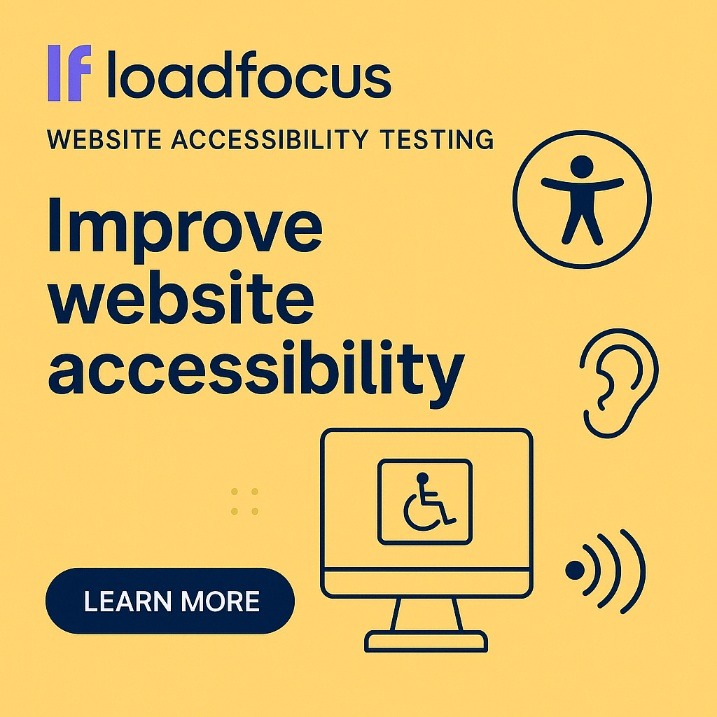In today’s digital era, website speed is a crucial factor that directly impacts user experience, search engine rankings, and conversion rates. With an increasing number of mobile users and a competitive online landscape, having a fast-loading website is non-negotiable. In this article, we’ll review the top 10 website speed test tools for 2025, providing a comparative summary, detailed insights, and answering common questions related to website performance. We’ll also highlight key features like Load Testing and Website Speed Test from LoadFocus, a top option in this space.
Comparative Summary of Website Speed Test Tools
| Tool | Best For | Key Features | Use Case |
|---|---|---|---|
| LoadFocus Website Speed Test | Comprehensive performance analysis | Real-time monitoring, detailed load reports, custom scenarios | Ideal for both small and large-scale sites |
| GTmetrix | In-depth performance insights | Advanced page analysis, waterfall charts, performance scores | Optimizing resource-heavy pages |
| Google PageSpeed Insights | Mobile and desktop performance optimization | Data from Chrome User Experience Report, actionable suggestions | Websites needing improvement in mobile speed |
| Pingdom Website Speed Test | User experience focused insights | Detailed performance grades, recommendations, uptime monitoring | E-commerce and content-heavy websites |
| WebPageTest | Detailed diagnostics | Multi-location testing, advanced video capture, waterfall charts | Developers needing granular performance data |
| Dareboost | Comprehensive quality analysis | SEO checks, security analysis, performance insights | All-round website optimization |
| Uptrends Website Speed Test | Global performance monitoring | Multi-browser support, real-time alerts, historical trends | Websites with international audiences |
| Dotcom-Monitor Website Speed Test | Simplicity with detailed reports | Instant speed test, waterfall charts, device-specific results | Small to medium business websites |
| Site24x7 Website Speed Test | All-in-one monitoring suite | Real user monitoring, detailed analytics, uptime reports | Enterprises and mission-critical websites |
| KeyCDN Website Speed Test | Quick and efficient testing | Real-time results, performance grading, historical data | Blogs and content sites requiring fast feedback |
The 10 Best Website Speed Test Tools for 2025
1. LoadFocus Website Speed Test
Category: Comprehensive Performance Analysis
Overview:
LoadFocus offers a robust website speed testing tool that combines real-time monitoring with detailed load reports. It’s ideal for those who want to simulate various load scenarios and improve overall performance. Its integration with Page Speed Monitoring and API Monitoring makes it a complete solution for performance testing.
Key Features:
Is Your Infrastructure Ready for Global Traffic Spikes?
Unexpected load surges can disrupt your services. With LoadFocus’s cutting-edge Load Testing solutions, simulate real-world traffic from multiple global locations in a single test. Our advanced engine dynamically upscales and downscales virtual users in real time, delivering comprehensive reports that empower you to identify and resolve performance bottlenecks before they affect your users.
- Customizable test scenarios
- Detailed performance reports
- Real-time analytics and alerting
- Integration with Free Load Test options
Pros: - Comprehensive and versatile
- Suitable for websites of all sizes
- Easy-to-understand reports
Cons: - Advanced features may have a learning curve for beginners
Use Case:
Ideal for businesses and developers who require in-depth analysis and continuous monitoring of website performance.
2. GTmetrix
Category: In-depth Performance Insights
Overview:
GTmetrix provides advanced page analysis with detailed waterfall charts and performance scores. It helps pinpoint specific issues that slow down your website.
Key Features:
- Comprehensive page analysis
- Waterfall charts for resource tracking
- Customizable test regions and devices
Pros: - Detailed insights and recommendations
- Free version available with robust features
Cons: - Some advanced features require a premium plan
Use Case:
Perfect for web developers and digital marketers looking to optimize resource-heavy pages.
3. Google PageSpeed Insights
Category: Mobile and Desktop Optimization
Overview:
Google PageSpeed Insights analyzes your website’s performance on both mobile and desktop platforms. It provides actionable suggestions based on real user data.
Key Features:
- Mobile and desktop performance scores
- Actionable optimization recommendations
- Integration with Chrome User Experience Report
Pros: - Free and easy to use
- Data-driven insights
Cons: - Limited customization options
Use Case:
Great for website owners seeking to improve mobile performance and user experience.
4. Pingdom Website Speed Test
Category: User Experience Focused Insights
Overview:
Pingdom’s tool is renowned for its user-friendly interface and detailed performance grades. It offers actionable recommendations to boost website speed.
Key Features:
Think your website can handle a traffic spike?
Fair enough, but why leave it to chance? Uncover your website’s true limits with LoadFocus’s cloud-based Load Testing for Web Apps, Websites, and APIs. Avoid the risk of costly downtimes and missed opportunities—find out before your users do!
- Real-time performance monitoring
- Detailed performance grades
- Uptime and transaction monitoring
Pros: - Intuitive and easy to navigate
- Excellent for identifying bottlenecks
Cons: - Premium features can be costly
Use Case:
Ideal for e-commerce sites and content-heavy platforms that require constant uptime monitoring.
5. WebPageTest
Category: Detailed Diagnostics
Overview:
WebPageTest provides extensive diagnostic data, including multi-location testing and video capture of page load behavior.
Key Features:
- Multi-location and multi-browser testing
- Advanced diagnostic data
- Visual comparison tools
Pros: - Extremely detailed analysis
- Free to use
Cons: - Interface can be overwhelming for beginners
Use Case:
Best suited for developers who need granular performance details for troubleshooting.
6. Dareboost
Category: Comprehensive Quality Analysis
Overview:
Dareboost offers an all-in-one solution that not only tests speed but also provides insights into SEO and security.
Key Features:
- SEO and security checks
- Detailed performance scoring
- Custom reports and recommendations
Pros: - Multi-dimensional analysis
- User-friendly interface
Cons: - Some features require a subscription
Use Case:
Ideal for businesses looking for comprehensive website quality checks beyond mere speed.
7. Uptrends Website Speed Test
Category: Global Performance Monitoring
Overview:
Uptrends focuses on real-time testing from multiple locations worldwide, making it invaluable for international websites.
Key Features:
- Global testing from multiple servers
- Detailed historical performance trends
- Customizable alerts and reports
Pros: - Excellent for global performance insights
- Reliable and scalable
Cons: - Pricing can be steep for smaller websites
Use Case:
Perfect for large enterprises and websites with an international audience.
8. Dotcom-Monitor Website Speed Test
Category: Simplicity with Detailed Reports
Overview:
Dotcom-Monitor offers an intuitive speed testing tool that provides clear reports and waterfall charts, making it easy to identify performance issues.
Key Features:
LoadFocus is an all-in-one Cloud Testing Platform for Websites and APIs for Load Testing, Apache JMeter Load Testing, Page Speed Monitoring and API Monitoring!
- Instant speed test results
- Detailed waterfall charts
- Device-specific performance insights
Pros: - Easy to use
- Quick insights
Cons: - Limited advanced features
Use Case:
Best for small to medium business websites seeking quick performance snapshots.
9. Site24x7 Website Speed Test
Category: All-in-One Monitoring Suite
Overview:
Site24x7 not only tests website speed but also offers uptime and real-user monitoring, providing a holistic view of website performance.
Key Features:
- Real user monitoring
- Uptime and performance analytics
- Detailed load time breakdown
Pros: - Comprehensive monitoring features
- Easy integration with other tools
Cons: - Some features may be redundant for simple websites
Use Case:
Ideal for enterprises and mission-critical websites that require continuous monitoring.
10. KeyCDN Website Speed Test
Category: Quick and Efficient Testing
Overview:
KeyCDN offers a straightforward tool that provides real-time results and performance grades, perfect for quick checks and continuous monitoring.
Key Features:
- Instant speed test results
- Performance grading
- Historical data tracking
Pros: - Fast and easy-to-use
- Free tool with no signup required
Cons: - Fewer advanced diagnostics compared to other tools
Use Case:
Great for bloggers and content sites needing rapid feedback on load times.
FAQs
What is the meaning of website speed?
Website speed refers to the time it takes for a webpage to fully load and display its content to the user. It includes the loading of HTML, CSS, JavaScript, images, and other resources.
What is a good website speed?
A good website speed is generally one that loads in under 3 seconds. Faster load times contribute to better user experience, improved SEO rankings, and higher conversion rates.
What is a good speed index for a website?
The speed index is a metric that measures how quickly the contents of a page are visibly populated. A speed index below 3 seconds is considered excellent, with anything under 2 seconds being ideal.
How to improve website speed?
Improving website speed can be achieved by optimizing images, leveraging browser caching, minimizing HTTP requests, and using a Content Delivery Network (CDN). Techniques like Load Testing and Page Speed Monitoring can help identify and resolve performance bottlenecks.
Why does website speed matter?
Website speed is critical because it directly affects user engagement, bounce rates, conversion rates, and SEO rankings. A fast website enhances user experience and keeps visitors engaged, which is essential in a competitive digital marketplace.
What is the good speed of Internet?
While internet speed varies by region and provider, a download speed of 25 Mbps or higher is generally considered good for most online activities. However, for optimal website performance, the focus should be on reducing load times rather than just high bandwidth.
Recent Trends & Statistics
Recent industry research in 2025 shows that over 75% of users expect a webpage to load within 3 seconds. Studies reveal that websites with load times under 2 seconds can experience up to 50% higher conversion rates compared to slower sites. Additionally, improvements in mobile network infrastructure and the widespread adoption of optimization techniques such as API Monitoring and Free Load Test have driven average page load times down by nearly 10% in the past year.




